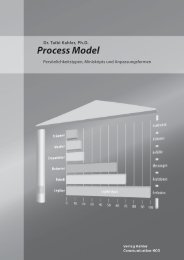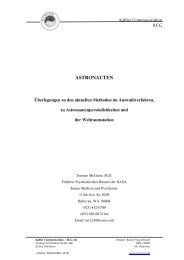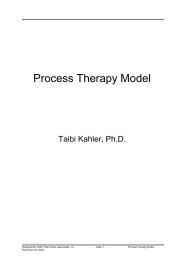Process Therapy Model - bei Kahler Communication
Process Therapy Model - bei Kahler Communication
Process Therapy Model - bei Kahler Communication
Create successful ePaper yourself
Turn your PDF publications into a flip-book with our unique Google optimized e-Paper software.
Resurrecting and re-examining the original research was necessary, as well as new research. I<br />
had discovered phase, and later the issues as to why we phase.<br />
This insight led to the creation of the <strong>Process</strong> <strong>Communication</strong> <strong>Model</strong>® 8 , the non-clinical<br />
outgrowth of both positive and negative miniscripts. At the time I had been hired by Dr. Terry<br />
McGuire, psychiatric consultant to NASA for many years. Terry saw the predictive and team<br />
interactional value of the models, and subsequently used PCM in his interviews for selection of<br />
astronauts until his retirement in 1996. As hundreds of the best of the best needed to be<br />
interviewed in person, it was time to validate a paper and pencil questionnaire that would<br />
produce the same personality dynamics information that we were getting in the interviews.<br />
NASA helped to fund this study, which took me two years, resulting ultimately in PCM<br />
inventories, profiles, and seminars, as well as solidifying the PTM presentations. Terry and I<br />
became the best of friends, training together many of his psychiatric residents in PTM for years.<br />
He is soon to publish his book, which will include applications of the PTM for the general<br />
public.<br />
Research did yield evidence [1982] 9 of six Personality Types stacked and ordered in each of us.<br />
Furthermore, there were significant correlations with each positive Personality Type and the way<br />
the world was viewed-- perceptions, as well as the strongest ego state, favorite transaction, and<br />
preferred psychological need (to name a few relevant to PTM). And although we each have<br />
access to these six personality “floors” within us, only one miniscript will be observable in<br />
normal distress -- that of the phase [“floor” that determines our current psychological need(s)].<br />
Two out of three people in North America will exhibit a different Personality Type miniscript<br />
when in normal distress, as opposed to severe distress 10 . One out of three people in North<br />
America will exhibit the same Personality Type miniscript whether experiencing normal or<br />
severe distress 11 .<br />
My personality type terms that I have used since 1979, with the publication of Managing with the<br />
<strong>Process</strong> <strong>Communication</strong> <strong>Model</strong> 12 are: Workaholic, Reactor, Persister, Dreamer, Rebel,<br />
Promoter. When I speak of a given personality type miniscript, I do not refer to a clinical<br />
diagnosis, but rather give correlations with psychological needs, drivers, injunctions, games,<br />
scripts, failure mechanisms, life positions, rackets, roles, negative ego states, and myths.<br />
Dr. Paul Ware 13 was the first in T.A. to condense classical diagnostic categories into adaptations,<br />
identifying them as: Hysterical, Obsessive-Compulsive, Paranoid, Schizoid, Passive-Aggressive,<br />
and Antisocial. Independently Paul and I wrote of six categories: my frame of reference from<br />
miniscript combined with my 1972 research; his from simplifying classical neuroses, personality<br />
disorders, and psychoses nomenclatures into linear adaptations, and speculating on their Drivers<br />
and injunctions. He included his treatment intervention model of feelings, thoughts, and<br />
behaviors for each, but did not identify miniscripts, rackets, ego states, games, roles, injunctions,<br />
scripts, transactions, three degrees of distress or any other T.A. terminology.<br />
Paul is a psychiatrist with many years of experience, and is currently Head of the School of<br />
Medicine at LSU. We are undertaking a research project of profiling patients with the TASP,<br />
assessing them by his adaptations, and correlating the results with classical diagnostic categories<br />
of the DSM-IV. Then we intend to combine efforts to train professionals in using our approaches<br />
in doing psychotherapy and counseling.<br />
©September 2004 Taibi <strong>Kahler</strong> Associates, Inc. Page 4 The <strong>Process</strong> <strong>Therapy</strong> <strong>Model</strong> ©<br />
November 28, 2005





